In this guide, we’ll be getting down to the business of prepping, painting, and accessorizing your pool. To reference information about paint type, pool type, amount of paint to buy, or any other purchasing-related questions, check out our Pool Paint Buyer’s Guide.
Let’s get started!
Step 1: Time Your Pool Painting Project
The weather and temperature have everything to do with how well and quickly a pool painting project will go. Typically, you should try to find a stretch of time of a minimum of one week, where there will be no rain and hopefully at least a few hours of sun during the day. This can be tricky during springtime. Avoid painting if the temperature is below 40°F, above 90°F, or if it is extremely humid. Avoid high winds that blow all kinds of spring tree debris into your pool.
Before and after painting, the pool needs to be very dry, unless you are using acrylic pool paint or epoxy primer. If you experience rain or wind blown debris before or soon after painting, get out there with a leaf blower and clean shoes, and clean out the pool of debris and rainwater as soon as possible.
Another thing to consider is how high the water table is prior to draining your pool. It is usually a bad idea to drain a pool too soon after (or right before) a large storm. The concern here is that the higher water table can “float” the pool. This happens when the forces pushing up the pool overwhelm the forces keeping the pool in the ground, and the pool literally floats out of the ground.
To avoid floating your pool, open up the hydrostatic relief caps that are plastered into the floor of plastered pools. Look for small white plastic circles in the floor. Chip out the plaster on the inside of the cap, and use large straight pliers to twist it out as soon as water gets low enough to reach the cap.
Step 2: Prep Your Pool for Paint
- Drain the pool and open hydrostats.
- Scrape away loose paint; repair and fill any cracks or hollow spots.
- Rinse and scrub with TSP (Tri-Sodium Phosphate) to remove oils.
- Acid wash the pool surfaces to roughen the surface.
- Rinse the pool to remove any acid or TSP residue.
- Pump out any remaining water and let dry completely (3-5 days).
- Tape up any lights, tiles, and fittings with painter’s tape.
Acid washing a pool for painting can be a hazardous procedure. This normally involves diluted muriatic acid, a flower watering can, and a garden hose to rinse quickly. It may be safer to use our TSP that you mix with water. It covers 800 square feet of surface area.
Follow all manufacturer’s directions on the Surface Prep Kit (or similar kits that include the TSP wash and the acid etching solution) closely to help you get through the prep process, and create a clean and rough surface to assist in your new paint bond.
Step 3: Painting the Pool
Now that your pool has been prepped and is completely dry, we’re ready to paint. If your pool has never been painted before, or if the surface is very rough, you should plan on adding a primer. Primers improve the bond and extend the more expensive pool paints. Depending on your pool surface type, there are many primers available, including epoxy and gunite.
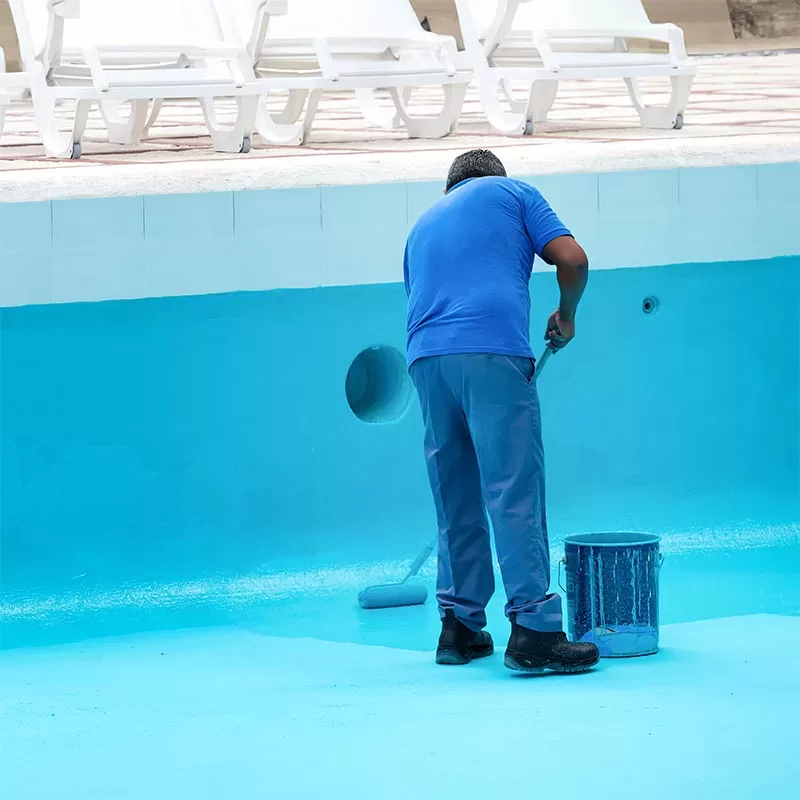
Remember to mix your paint thoroughly. Use a power drill with a mixing paddle to ensure that your pool paint is mixed properly. Epoxy paints have an additive that begins a reaction when you mix it into the paint, and each batch should be used within a few hours. When painting you want to start at the deep end and work your way to the shallow end. Use a telescoping pole to reach all the way up the walls.
Use a low nap roller, 3/8 inch nap or less, for smooth surfaces. A 5-gallon bucket with a grid works better than a low, flat paint pan. Buy a wooden extension pole that you can screw into the roller frame so that you can roll the paint more easily. Overlap just slightly and use an even pressure for the best finish. Use a small cut-in brush to handle the 90 degree corners around steps and swim outs.
Before, during and right after painting, blow off the pool deck with a leaf blower or a garden hose, to keep wind-blown debris from blowing in on your about-to-be-painted, or your just-freshly painted, pool surfaces. Also, keep your dog away.
Need more than one coat of paint?
For pool paints that require multiple coats, follow the appropriate directions and never rush a second coat of paint if the first coat is not ready. It can take 2-8 hours for a coat of paint to dry, depending on temperature, wind and humidity. Work fast but steadily, and monitor the amount of paint that you are using, so that you don’t end up running short on paint, or having much left over.
Don’t forget to have fun! While painting is a serious task, if you ever wanted to add any stencils or patterns on the pool walls or bottom, this is the perfect time! There are many neat ideas that people have come up with for making their pools look more fun – anywhere from stencils, to scatter/splatter painting, to logos, to full-on pool murals. It’s your pool, paint it how you like it!
Step 4: After Painting the Pool
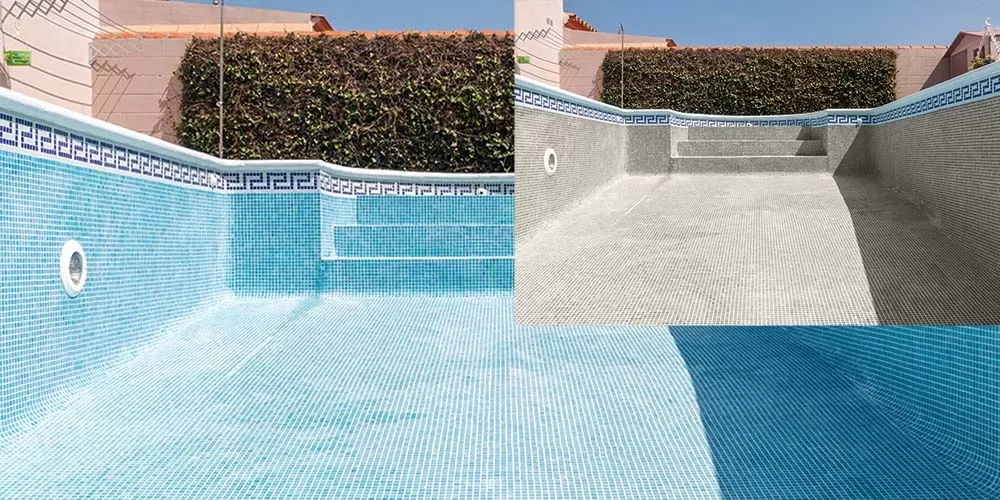
You have finished painting the pool. Looks good, doesn’t it? You can now remove any painter’s tape. Before thinking about doing anything crazy, like filling the pool with water right away – make sure you have given the paint sufficient time to dry. Usually this is 3-5 days, but make sure to double check the directions on the specific paint type you’ve used. If you get any rain or moisture during the drying time, remove the water as fast as possible and allow for extra dry time if the rain lasts for more than an hour or two.
When the pool paint is completely dry:
- Fill the pool with water without stopping until full
- Balance the pH, alkalinity, and hardness levels
- Start up the filter system and add chlorine tablets
- Add chlorine stabilizer and stain away
- Resume your normal chemical maintenance
Now the only thing to do is to enjoy the fruits of your labor!
Painted pools have a ceramic-like finish that resists stains and algae. Be sure to maintain proper water chemistry to help it stay that way longer!

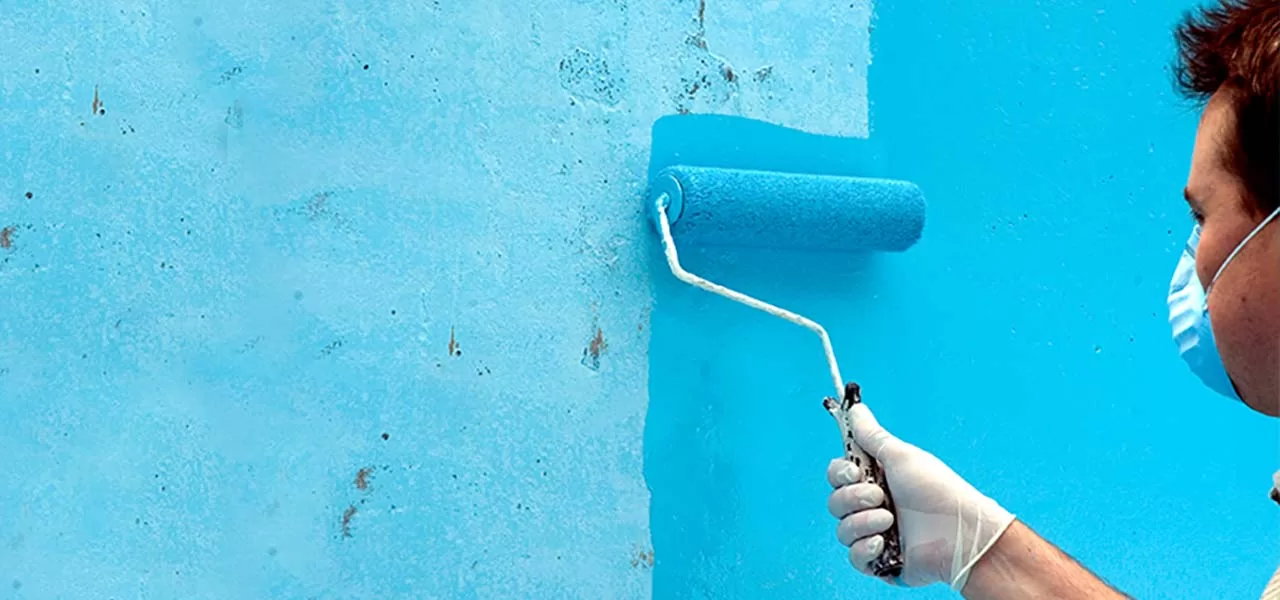

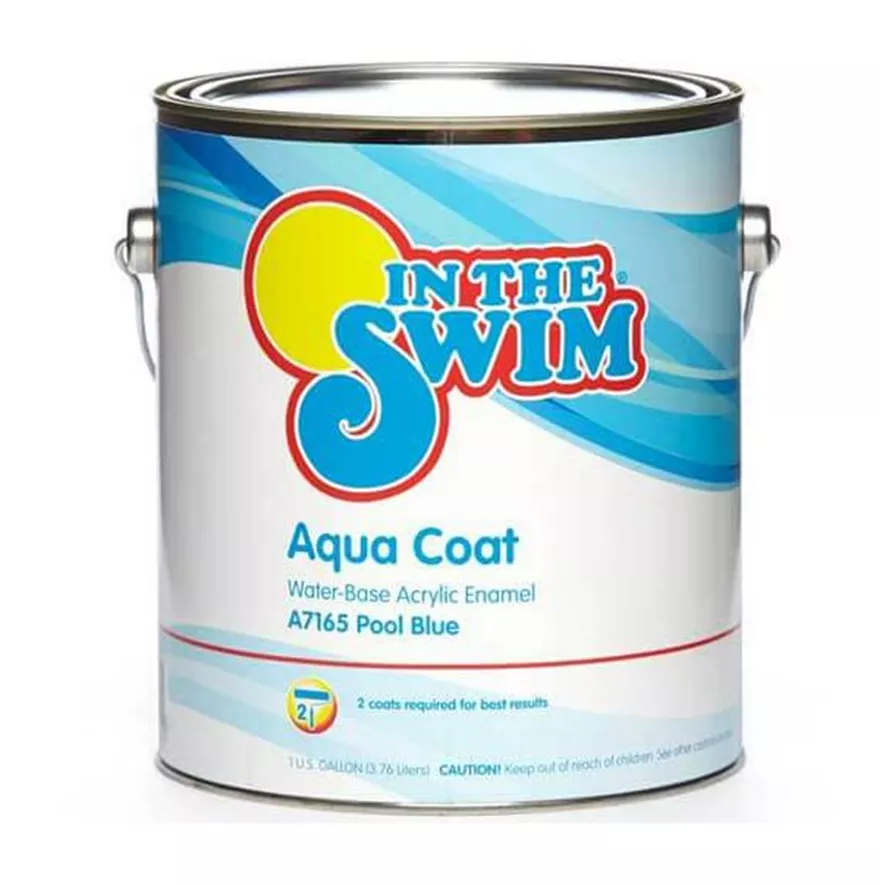
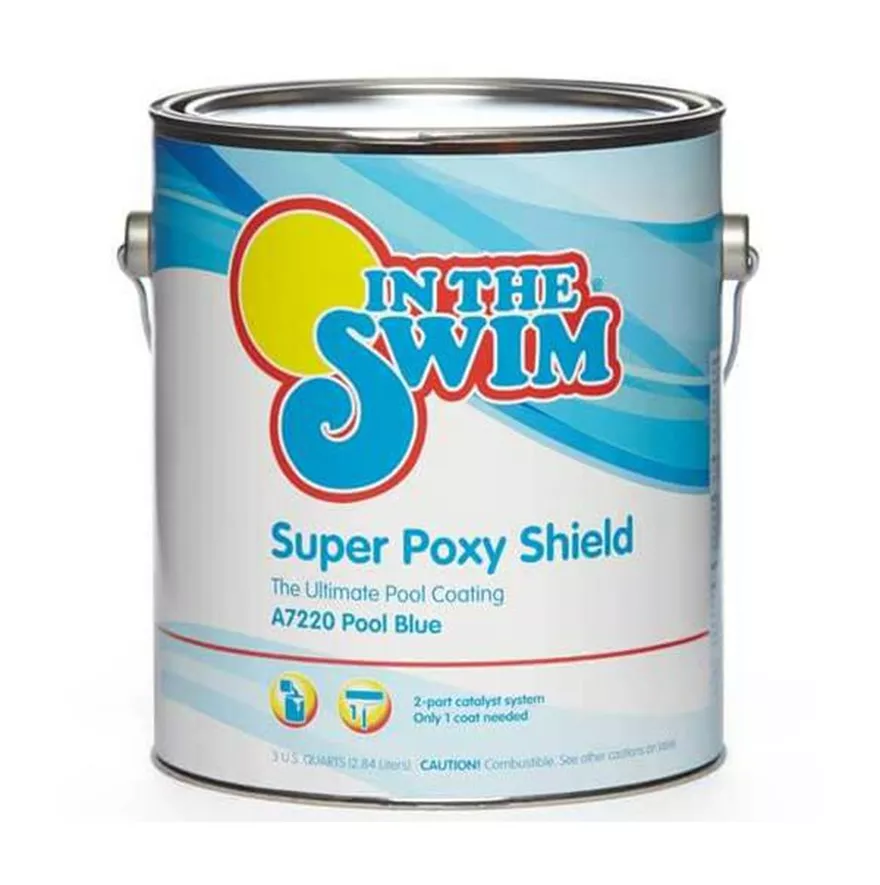
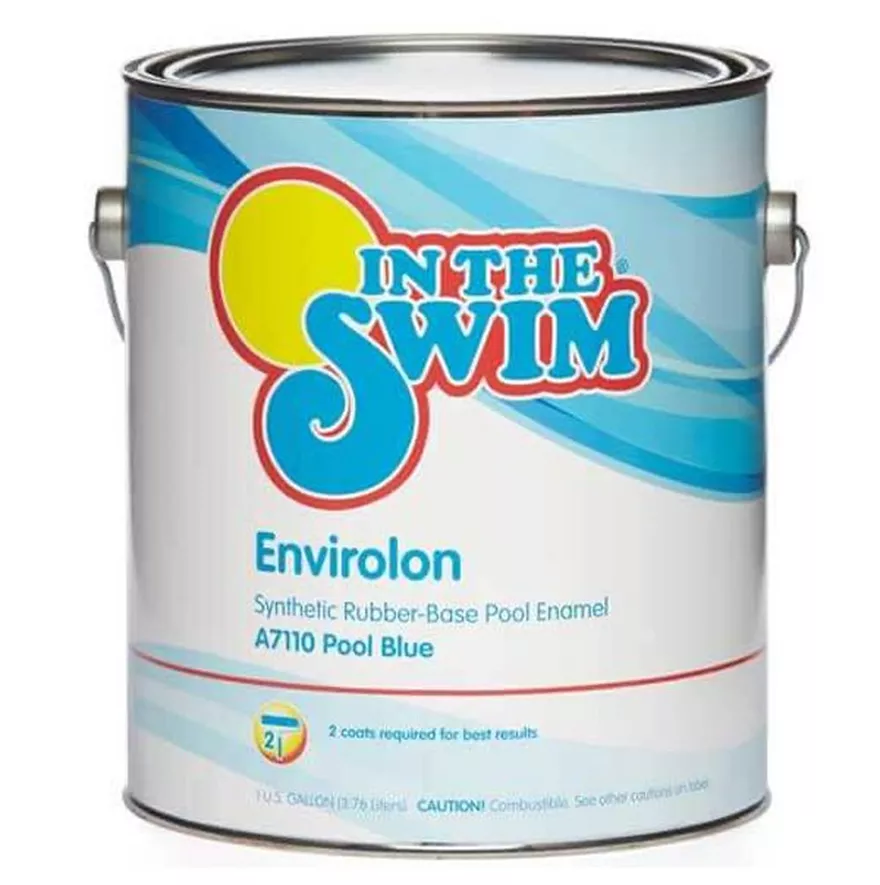

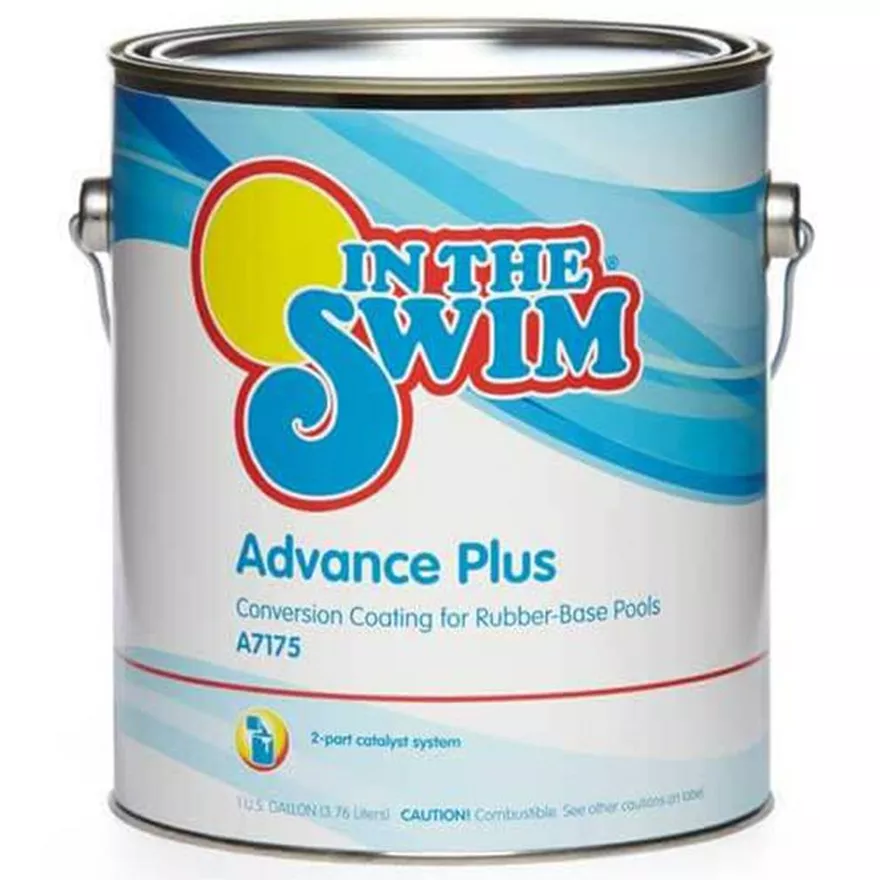
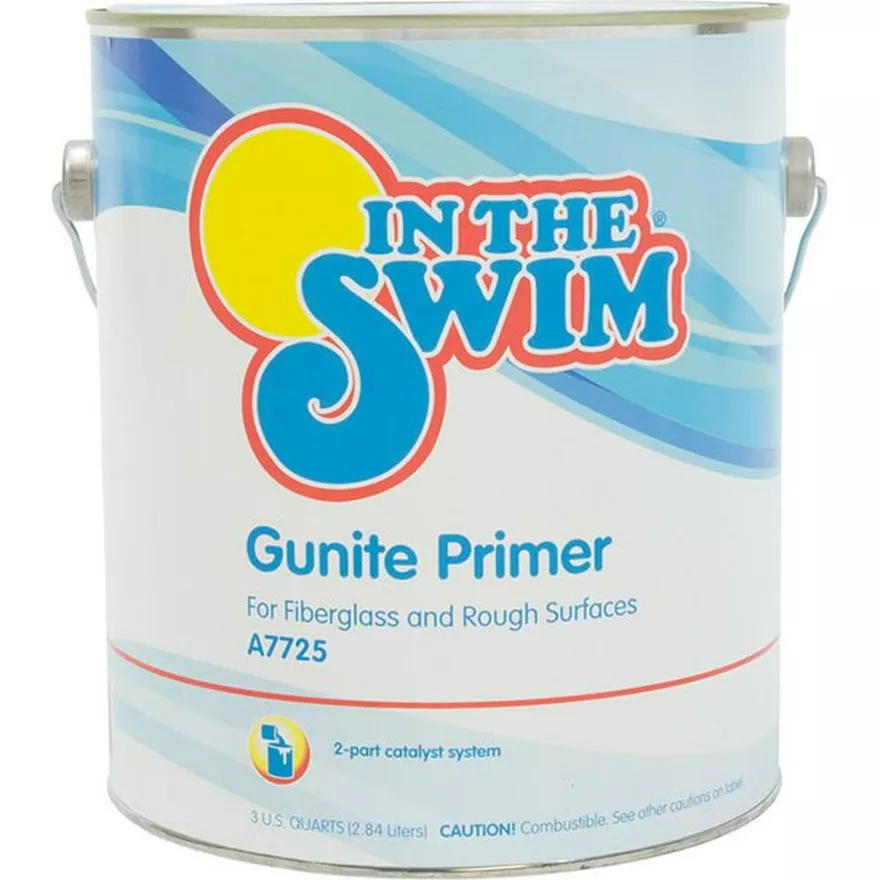
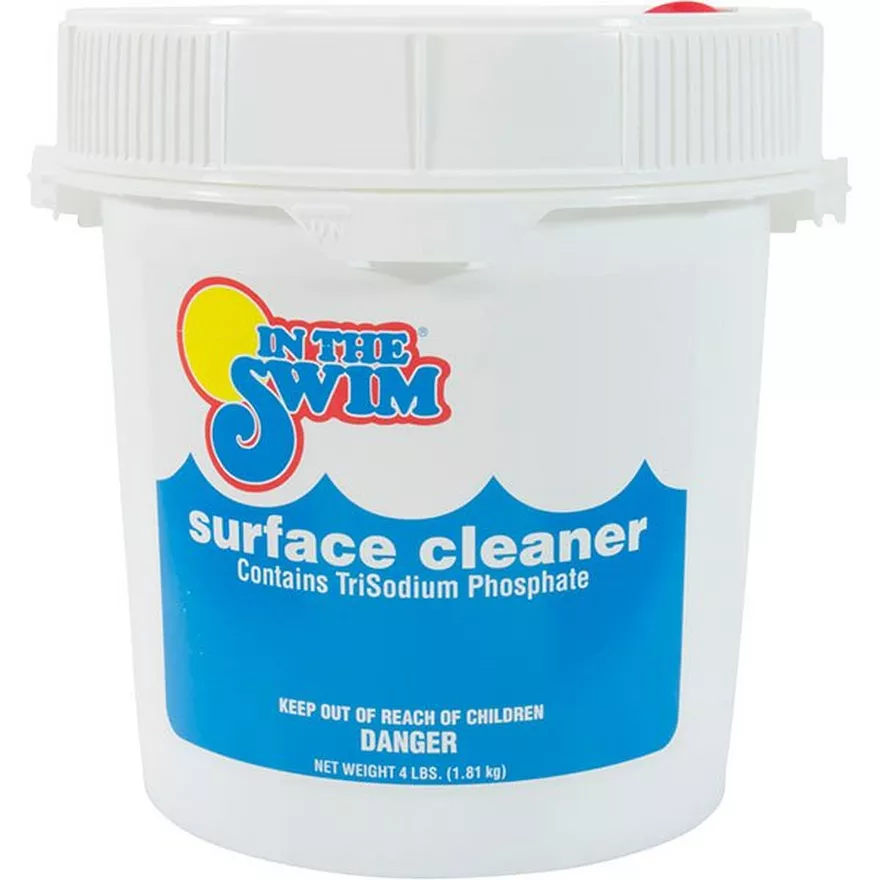

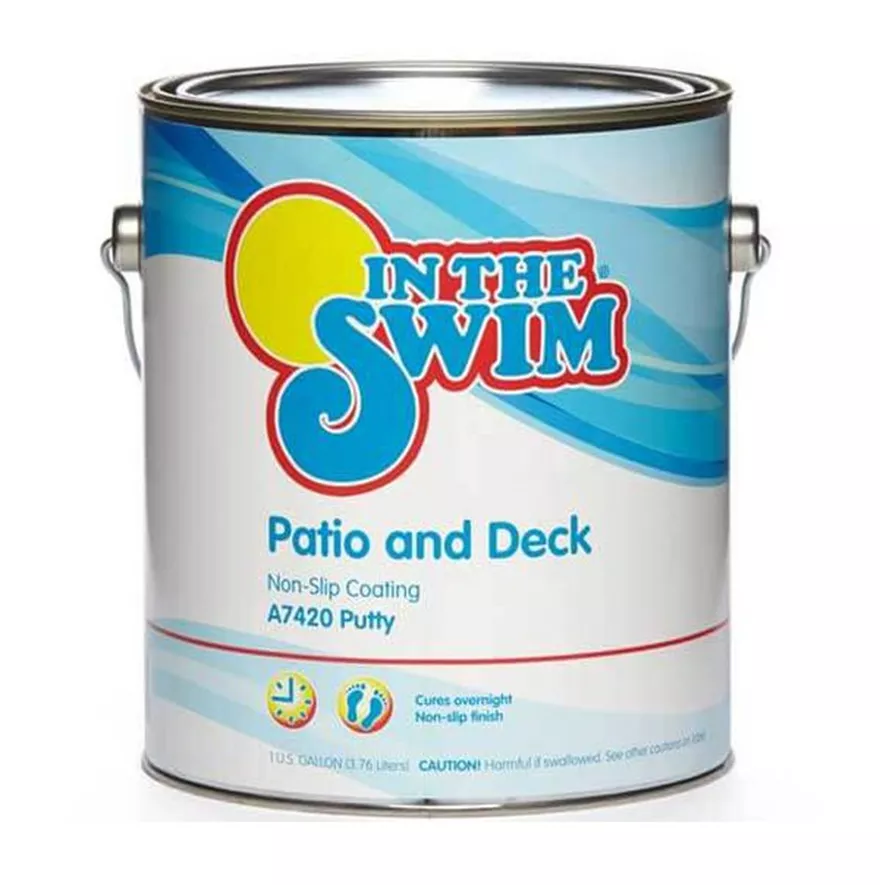
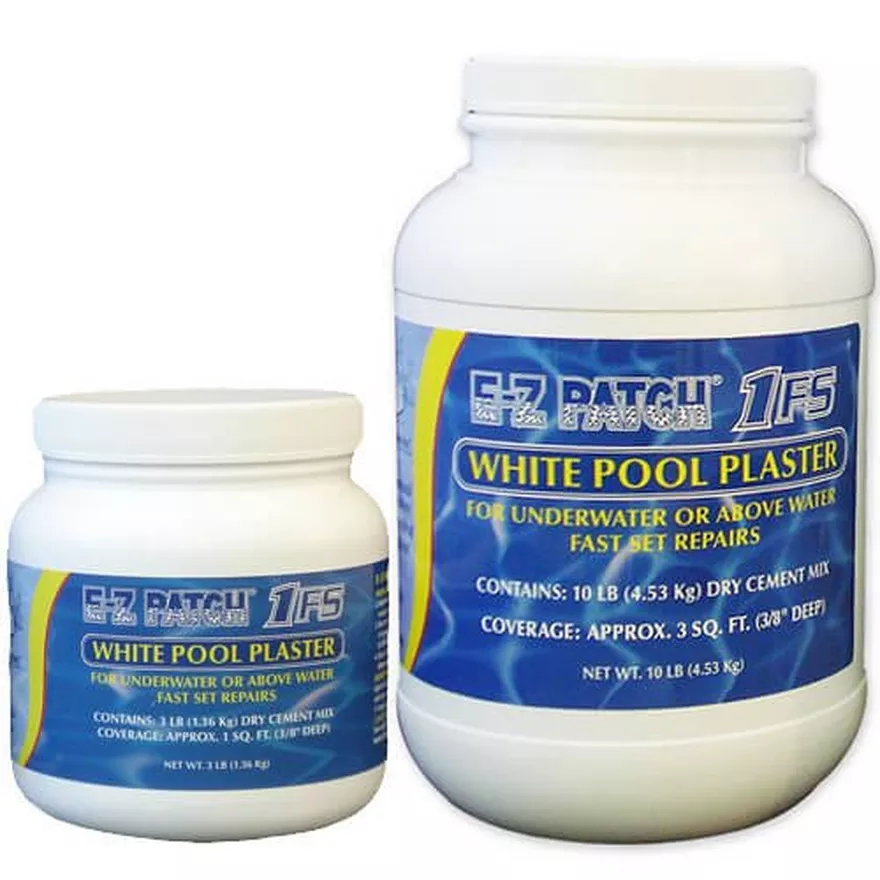
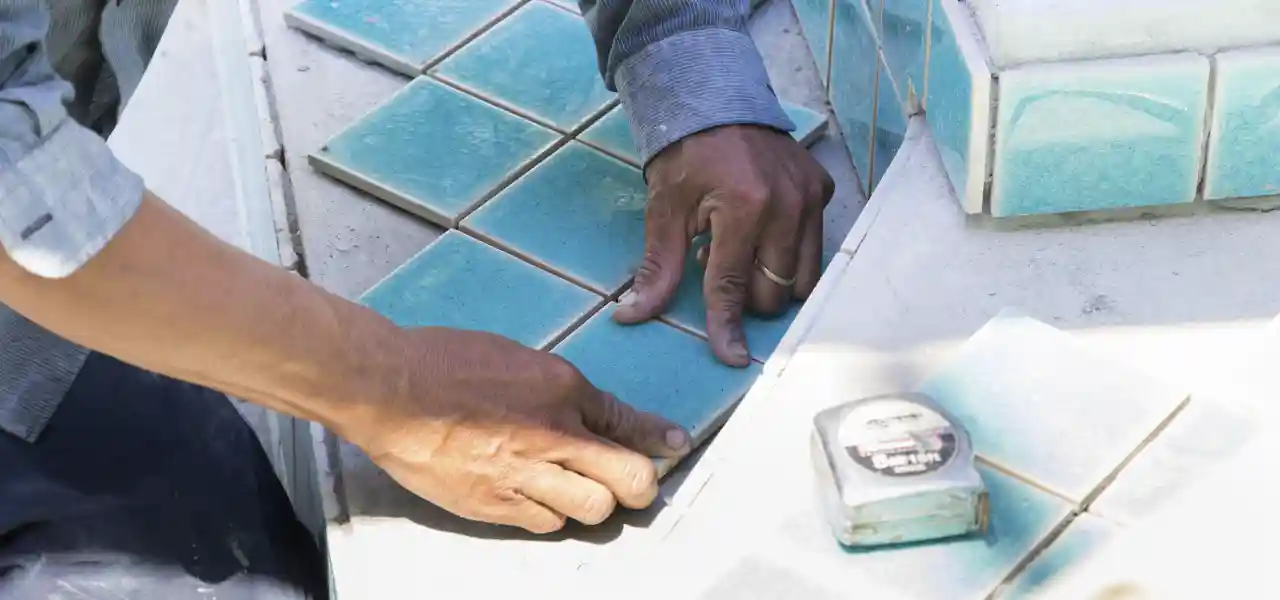
I have a gunite pool which needs resurfacing an I’m considering painting it with the epoxy paint with the primer. The surface is showing some erosion wear, especially nearer the surface on the wall. The floor seems a little smoother. The epoxy paint says “for new gunite”. Can this be used on my pool with the an older surface (7-10 years)? What kind of surface prep do I need to do to those areas if any before applying primer?
Hi Doug, I assume that you have a plaster finish. Epoxy paint will be fine if you have never painted before. For prep, follow the instructions listed on the can – TSP Wash > Acid Wash > TSP Wash > Dry > Paint > Dry > Fill
how long after applying Poxy Primer should I apply the Epoxy paint coat?
The label should be very specific with drying times, but in my experience, about 4-hours, give or take, depending on air temperature.
We are emptying our concrete pool and are at the last stages of draining however they are calling for 5 days of rain. If
we leave the balance of water &
sand, which is not much, prevent it from floating out of the ground?
Robert, find the hydrostatic relief plugs, in the floor of the pool, chip out the plaster, and open them up, remove the threaded plug, which looks like a plastic circle with a line thru it, about 1.5″ diameter. There is usually 3 or 4 in the floor, and one in the main drain pot. Open up 2 or 3 of them, to release hydrostatic pressure and let the water into the pool. Replace the plugs while refilling the pool (after painting) with Hayward SP1022B plugs.
I have a fiberglass pool that part of it is sanded to the gelcoat the other side is a high build epoxy paint . If I scuff up the painted side , can I use the gunite primer on the whole Pool before I use the epoxy paint or will the primer not adhere to the old epoxy paint ? Passed over the paint with 40grit on a sander
Ryan, sure you can do that, the primer will adhere to the epoxy paint, but be sure that you first do the prep on the entire pool (TSP wash, then Acid Etch), then dry for several days, per can label.
I have 15+ years old paint if the newer paints are so strong why can’t they bond to the old paint. The pool itself is from about 1976. Older home and pool city frowns on me filling it in with dirt but older and tired of putting money into it, just want a few more years out of it without having to refinish it since that is out of the budget thank you I hope this is enough information to help
Hi, you don’t have to refinish it, if you can stand the look of it. And new paint will bond with old paint, as long as you know the type (rubber, epoxy, acrylic) that was used before, or if unsure, use acrylic. Filling in a pool can be done, but must be done properly, the pool floor must be broken up, and the tops of the pool walls knocked off, and then filled and tamped with fill dirt. it can be $10,000 to fill-in a pool.
But do I need to get all of the old paint off or just any loose stuff, I was told it is ether rubber or epoxy from the person at the pool store that tested it, I guess the chip softened with both tests and was also told I need to do a primer first and they recommended the epoxy
I am so thankful that there are people that know about this, I am 72 and almost all maintenance of our home falls on me since my husbands heart surgery but I enjoy doing what I can
Hi Linda, I would rent a pressure washer for a day and try to get as much paint off as possible with that method, and using a putty knife or scraper as needed. If it is bonded on there tightly you do not have to remove it, but it would be better if you could, but if it won’t come off with a pressure washer, or scraper, then it’s on there pretty good, so no worries.Then, to prep for paint, you need to TSP wash the pool to degrease it, Acid wash the pool to descale it, and then another quick TSP wash to neutralize the acid and be sure all grease is gone, esp. around top of wall, steps and around drain. Then let the pool dry for 4-5 days, and be sure no weepers are still moist in the surface. Then Paint – epoxy is best, and yes use a primer first.
I have a older pool with stainless steel walls. Any suggestions on how best to clean/polish the stainless while I have the pool drained for painting ( lightly stained with some lite surface rust). The walls also have seams and I’m wondering if I should caulk them prior to refilling. I would like to use epoxy paint for long life but how do I know if it will be compatible with the previous (unknown) paint.
Epoxy is usually used for steel – but you never know, you can’t tell by looking at it. You can buy our paint solvents ($30 ea) and see which one will dissolve a paint chip from your pool, or you could call a local paint store and see if they do that, or you can send some paint chips to Ramuc paints, who will analyze it and send you results in a week or so. For paint prep, the most important thing is to degrease with TSP, and then acid wash to remove any scale, they don’t need polishing really, but you can sand to remove the rust. You can use a marine grade caulking, one that says you can paint over it when cured, and caulk the seams, just in case there might be a leak in the joint/weld.
We painted our pool on Tuesday morning. It rained on Wednesday night. I noticed about 4 inches of water in the pool on Thursday night. What should I do?
Hi Kent, you should pump out the water with a small pump, and use a mop or towels for other areas, to help it dry out faster. Add an extra day of dry time. Act fast, if you don’t have a pump, run down to the local rental shop and rent one for 4-hours.
Hi. We have cleaned our pool for painting and are waiting the recommended 3-5 days before painting. There is rain in the forecast. Can we still paint in the original time frame or do we need to wait another 3-5 days after the rain?
Add 1 day of dry time for each day of rain, or rain event. After the rain stops, Get into the pool (carefully, wet painted floors are very slippery), and use brooms and (electric, not gas) leaf blowers, to clear any standing water, and push toward the main drain, Then mop up around the drain, and the drain pot, or use small pump in the main drain, or shop vac and then pump out the shop vac (because it’s nearly impossible to get a shop-vac with more than a gallon or two inside, out of the deep end, believe me!).
Hello, we are getting ready to paint our fiberglass pool with concrete floor. The pool has been cleaned already with a power washer. We will be using TSP to clean it again. The fiberglass was previously painted, do we still need to sand the walls down before painting?
The sanding is important yes, as fiberglass pools can have a bit of a gloss or very smooth surface. A light scuffing-up helps the paint to bond better.
Hello. I’m from Hobbs nm, I have a covered pool inside, I have sand blasted it, what are my options, I’m wanting to go back with a white finish,thank you for your time
Hi Glenn, since you have sandblasted the pool, you could plaster the pool, for a price of $4K +/-, or you can paint the pool. If painting, there is no need to do the acid wash/tsp wash routine, if you paint soon, and the pool stays clean. You may want to smooth out any rough or pitted spots created by sandblasting, if any. Use a primer on the pool, Epoxy Primer, and then a thick coat of Super Poxy Shield. If there is leftover paint, do a second coat on pool steps and around the deep end drains. Sprinkle very fine sand over the steps after painting, or mix it into the paint used for a second coat on the steps, as anti-slip.
I’ve poured a couple thousand dollars into painting my pool for the last 4 years. Each time with an In the Swim rubber based pool paint. The prior owner had told me to use rubber based paint. Following and double following the prep guidelines each year the paint has bubbled and flaked off. You see my issue of not wanting to paint every year!! What would you recommend, an epoxy conversion and paint or going to an acrylic water based paint.
Hi Tom, bubbling and flaking is usually attributed to moisture or grease on the surface, preventing the bond. Some surfaces can hold significant moisture, deep in the wall. However, it is also known that rubber based has traditionally been an annual tradition, or at best a two-season paint. Acrylic paints are a two-year paint or at best a 3 or 4-year paint. Epoxy paints are a 5 year paint, or at best a 6 or 7-year paint. I would do an epoxy conversion, and along with the regular prep, consider also scuffing the surface afterwards with belt sanders or vibration-plate (handheld) sanders, to improve the bond of the conversion paint. Also, try to give a good long dry time, 5-7 days if possible, before painting with conversion paint. Then give it a thick coat of epoxy, once the conversion paint is dry to touch and walkable, (2-3 hours).
Hi Davy
Hope you doing well.
What happens if I fill my pool 24 hours after it was painted and have not given it 3 to 5 days to cure properly?
Hi there, well it may peel or blister I suppose. Perhaps rapidly, or perhaps after several months. I assume you are speaking of epoxy or rubber pool paint, and not acrylic, which does require lengthy dry time. If you can avoid it, it would be best to allow at least 48 hours of warm, sunny dry time. If weather is cool and cloudy, 4+ days may be needed, or longer if rainy and moist.
Hi, I need to paint my gunite pool in multiple spots at the the waterline that have peeled off to the plaster. I plan on using Kelly Tech: Prep Magic, Gunzite Epoxy Primer and Xeron Epoxy Paint. I intend to just lower the water to below the areas that have peeled. I will scrape and sand loose areas. Do I need to worry that any of these products will negatively contaminate the water? I understand there will be debris to remove, I am concerned about chemicals. Can I just refill, test and treat? Also: How long should I wait before painting and how long before refilling? The weather is nice here 60-80 degrees.
Thanks in advance for the help!
Hi Sharon, no problem with any stuff that falls in the pool, just vacuum it up, and the Prep Magic should not be a problem either. FOr the other questions, consult the label on the paint, it will cover it all in detail.
We are getting ready to paint a brand new concrete pool. What is the cure time for the concrete before we can start painting.
Hi Rachel, I would wait at least 30 days before painting new concrete. If using epoxy paint, use the Gunite Primer paint as the first coat…
hi i am going to paint a pool i just bought its about 25 years old in good shape its in a rv park for guest i was wondering whats the pros and cons of painting the pool black for your color chart thanks joe
Hi Joe, I’ve painted pools black before, and also done black with scatter/splatter blue over top of the black. Black pools do have a small solar benefit, will absorb slightly more heat. They also look more reflective. Some people don’t like a black pool however, makes them fearful of snakes, so it may discourage (some) guest use. It may make the bottom depth harder to judge for some people. Also, if the paint chips or peels in any areas, or when it wears thin, the white underneath will show through, more visibly than using white paint or blue paint. Also, if your pool is considered ‘public’ by the local zoning folks, black paint may be prohibited…
What may happen if you fill in spots/holes/chips but don’t acid wash those spots before you paint the pool?
Hi Michelle, probably nothing – the acid wash step serves two purposes, 1. to roughen up the surface for a better paint bond, and 2. to remove layers of deposited scale, mineral scale on the surfaces. So these patched areas would have no scale, and are probably rough enough – no worries, I think it’ll be fine.
Hi,
I’m Bob from Ramona (near San Diego), CA. I want to repaint with epoxy, but I have two large eucalyptus trees within “blowing distance” of my pool. I can basically guarantee that if I paint the pool, I’ll get leaves, berries, and probably twigs in it. Since I can’t stand sentry with a leafblower for 48 hours worth of paint/dry/repaint/redry, can I put a mesh safety cover over the freshly painted pool until it is at least no longer tacky (if not fully cured)? I understand this will be difficult to keep the cover off the paint, but if that could be done, would having that kind of cover hamper drying or damage the cover (given the VOCs from the epoxy)?
Hi Bob, I did that once, used a mesh safety cover during and after painting, due to spring debris. And if you do it carefully, with 2 people, the cover probably need not touch the pool floor. Attach one side, or one end, and two people can pull it across. It may dampen the dry time a small amount. I think we set up a fan in the deep end, and left the shallow end cover corners open, as I recall. It worked well! But, I don’t recommend painting under cover – we were pretty high from the fumes! 😉
Hello I’m from Phoenix az I have a window to paint my in ground pool from 4am to 8am temperature 81 to 88 after that the temperature goes up and will be in the 100 will the pain be okay and or will anything happen to the pain in the pool in the heat some people suggest or recommend not to paint its touch up not painting entire pool.all the bottom of the pool,around 4 inches up the wall and top edge around the pool.will it be okay?I want to do this in the earlie morning 06/30/17
Hi Christine, best temperatures for painting a pool are 60-80 degrees, and cool mornings are best. I think the paint will be OK if you are able to put it down in the early morning hours, before temperatures climb near 90. It will be mostly dry in a few hours. If just spot painting, perhaps you can shade the areas, with small tables or something to block direct sun, if that’s an issue. Not the best time of year to paint, in Arizona, probably march or november are the best months – but, I think you’ll be OK if it gets 4-6 hours of dry time before you hit 100, but on the other hand, i could be wrong! Hope it turns out OK, I’m fairly certain it will, but calling the paint manufacturer would give you more accurate advice.